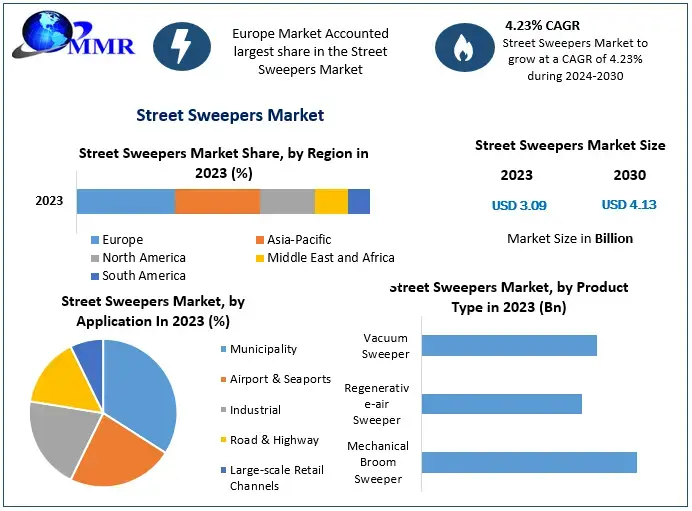Street Sweepers Market Poised for Significant Growth by 2030
Innovations in Electric Vehicles and Infrastructure Development Drive Market Expansion
The Street Sweepers Market Growth valued at approximately USD 3.09 billion in 2023, is projected to reach USD 4.13 billion by 2030, exhibiting a Compound Annual Growth Rate (CAGR) of 4.23% during the forecast period. This growth is primarily attributed to advancements in electric vehicle technology, increased urbanization, and the expansion of road infrastructure.
Market Definition and Overview
Street sweepers are specialized machines designed to clean city streets, removing debris such as litter, leaves, and small branches. Equipped with powerful internal combustion engines and hydrostatic drives, these machines are suitable for both indoor and outdoor applications. Modern street sweepers utilize vacuum-powered systems to efficiently collect waste, ensuring cleaner urban environments. Continuous technological advancements have led to the development of more environmentally friendly and efficient street sweeping solutions.
Market Growth Drivers and Opportunities
-
Adoption of Electric and Hybrid Vehicles: The automotive industry's shift towards electric and hybrid vehicles has significantly influenced the street sweepers market. Electric street sweepers offer benefits like zero emissions and improved energy efficiency. Governments worldwide are promoting the use of electric street sweepers among municipal corporations, manufacturing enterprises, and airports to reduce environmental impact. In response, manufacturers are developing high-capacity electric models to meet this growing demand.
-
Expansion of Road Infrastructure: Rapid urbanization has necessitated the development of extensive road networks. As new roads are constructed, the need for regular maintenance and cleaning increases, driving the demand for street sweepers. Additionally, integrated towns and industrial parks present lucrative opportunities for market expansion.
-
Labor Cost and Availability: High labor costs, frequent strikes, and a limited supply of human resources have prompted municipal authorities and project developers to seek mechanical solutions for street maintenance. Street sweepers offer an efficient alternative to manual cleaning, reducing dependency on human labor and associated costs.
-
Impact of COVID-19: The COVID-19 pandemic underscored the importance of citywide cleanliness. While initial concerns suggested that street sweepers might contribute to virus spread by suspending droplets, further studies emphasized their role in maintaining hygiene. Consequently, many municipalities increased street cleaning efforts during the pandemic, boosting the demand for advanced street sweeping equipment.
Segmentation Analysis
The street sweepers market can be segmented based on product type, application, and propulsion type.
-
By Product Type:
- Mechanical Broom Sweepers: Utilize rotating brushes to collect debris into a hopper. They are effective for heavy-duty cleaning tasks, especially in areas with larger debris.
- Vacuum Sweepers: Employ suction mechanisms to draw debris into containment units. These sweepers are ideal for urban settings with fine dust and smaller particles.
- Regenerative Air Sweepers: Combine mechanical and vacuum technologies, using blasts of air to dislodge debris, which is then vacuumed into the hopper. They offer versatility across various cleaning scenarios.
-
By Application:
- Municipal: City and town administrations use street sweepers to maintain public roads, ensuring cleanliness and public health.
- Industrial: Facilities such as factories and warehouses deploy sweepers to keep their premises free from debris, ensuring safety and operational efficiency.
- Airport: Airports require specialized sweepers to maintain runways and taxiways, preventing Foreign Object Debris (FOD) that could endanger aircraft operations.
-
By Propulsion Type:
- Electric: Powered entirely by electric batteries, these sweepers produce zero emissions and are gaining popularity due to environmental concerns and regulatory support.
- Hybrid: Combine internal combustion engines with electric motors, offering a balance between performance and environmental benefits.
- Conventional: Rely solely on internal combustion engines, typically using diesel or gasoline. While they offer robust performance, there is a gradual shift towards more sustainable alternatives.
Learn More:https://www.maximizemarketresearch.com/request-sample/88042/
Country-Level Analysis
-
United States: The U.S. market is experiencing growth due to increased investments in infrastructure development and a strong emphasis on environmental sustainability. Government initiatives promoting the adoption of electric vehicles, including street sweepers, are further propelling market expansion.
-
Germany: As a leader in automotive engineering and environmental policies, Germany is witnessing a surge in demand for electric and hybrid street sweepers. The country's stringent emission regulations and commitment to green technologies drive the adoption of advanced street cleaning solutions.
Competitive Analysis
The street sweepers market is characterized by the presence of several key players focusing on innovation, product development, and strategic partnerships to enhance their market position. Notable companies include:
-
Aebi Schmidt Group: Renowned for its extensive range of street cleaning equipment, Aebi Schmidt emphasizes innovation and sustainability in its product offerings.
-
Bucher Industries: A prominent player offering a diverse portfolio of municipal vehicles, including advanced street sweepers designed for various applications.
-
Dulevo International: Specializes in industrial and urban cleaning solutions, with a focus on high-performance and environmentally friendly sweepers.
-
Elgin Sweeper Company: With a rich history, Elgin provides a wide array of street sweepers known for their durability and efficiency.
-
Fayat Group: Through its subsidiary, Mathieu, Fayat offers compact and versatile sweepers suitable for urban environments.
These companies are investing in research and development to introduce electric and hybrid models, aligning with global sustainability trends. Collaborations with municipal bodies and participation in public tenders are common strategies to expand their market presence.
Conclusion
The global street sweepers market is on a trajectory of steady growth, driven by technological advancements, urban infrastructure development, and a shift towards sustainable practices. The increasing adoption of electric and hybrid street sweepers, supported by governmental policies and environmental awareness, is reshaping the market landscape. As urban areas continue to expand, the demand for efficient and eco-friendly street cleaning solutions is expected to rise, offering significant opportunities for industry participants.

Comments on “Street Sweepers Market Growth Accelerates with Smart City Development”